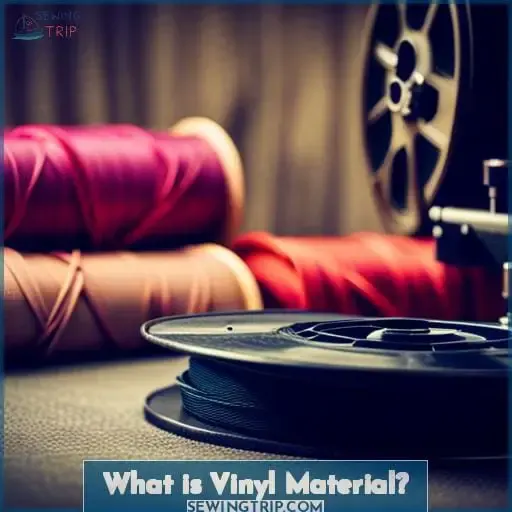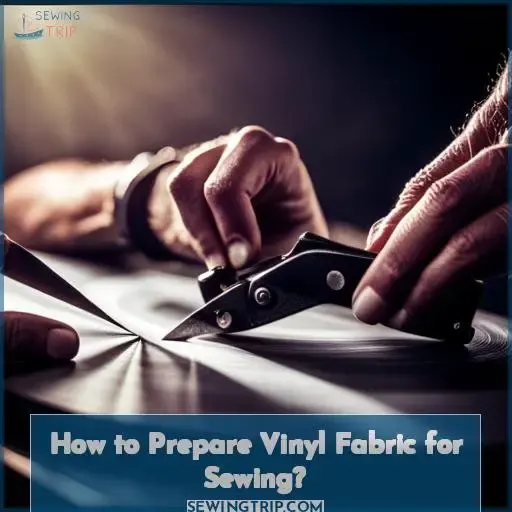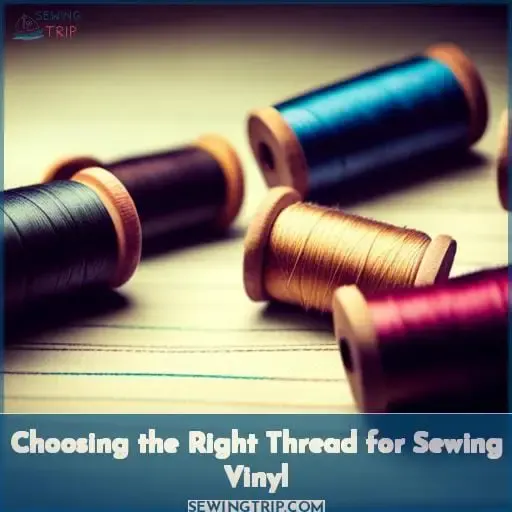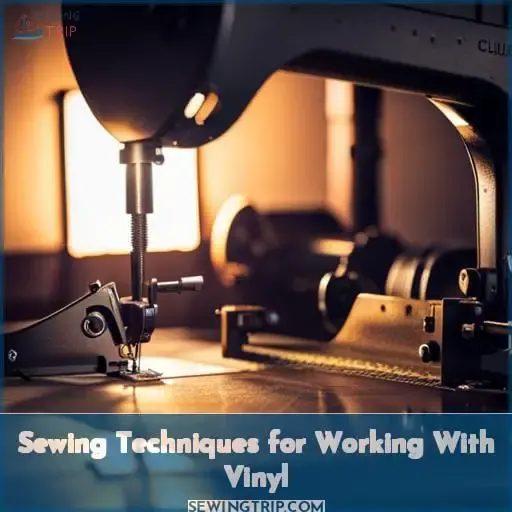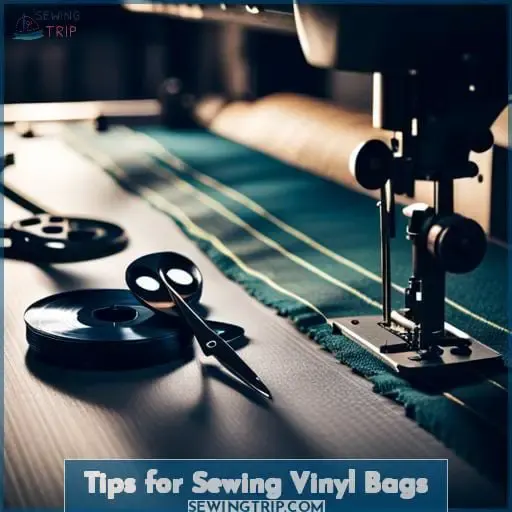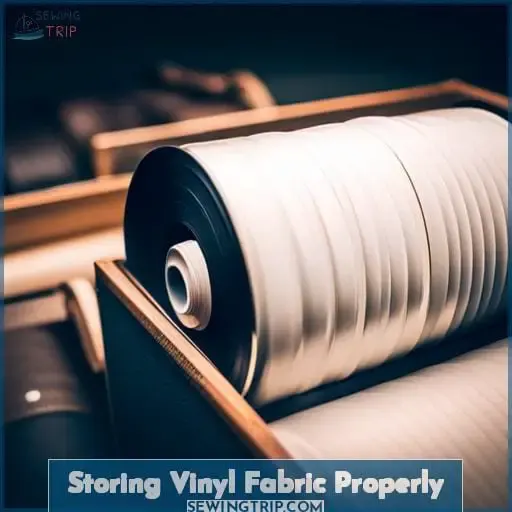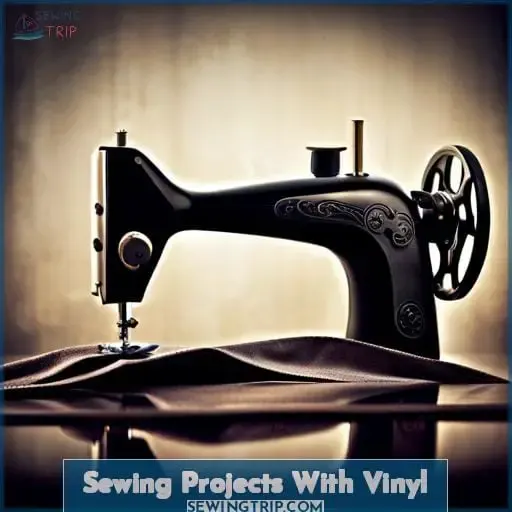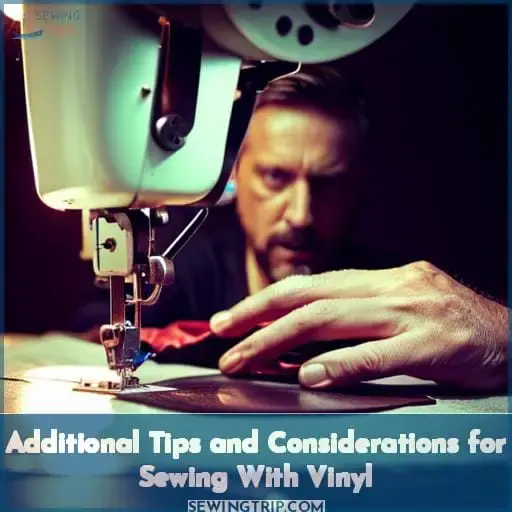This site is supported by our readers. We may earn a commission, at no cost to you, if you purchase through links.
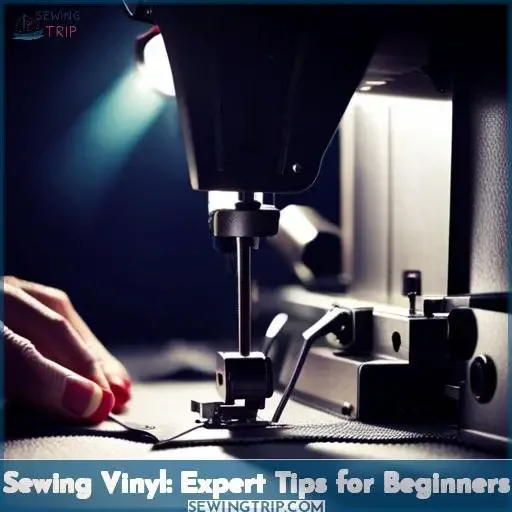 Ready to take your sewing skills to the next level? Discover expert tips and tricks for sewing vinyl like a pro.
Ready to take your sewing skills to the next level? Discover expert tips and tricks for sewing vinyl like a pro.
Vinyl fabric may seem intimidating, but with the right techniques, you’ll be able to tackle any project with confidence. From choosing the right thread to mastering special presser feet, this article will guide you through every step of working with vinyl.
Say goodbye to limitations and hello to endless possibilities in your sewing journey!
Table Of Contents
- What is Vinyl Material?
- Where to Buy Vinyl Materials?
- How to Prepare Vinyl Fabric for Sewing?
- Choosing the Right Thread for Sewing Vinyl
- Sewing Techniques for Working With Vinyl
- Tips for Sewing Vinyl Bags
- Storing Vinyl Fabric Properly
- Sewing Projects With Vinyl
- Additional Tips and Considerations for Sewing With Vinyl
- Conclusion
What is Vinyl Material?
Vinyl material is a type of fabric that encompasses various colors, weights, and textures.
- Bags
- Upholstery
- Placemats
- Toys
Types and Characteristics of Vinyl
Vinyl is a versatile material that comes in various colors, weights, and textures.
Vinyl is known for its durability, flexibility, and resistance to abrasion.
When sourcing vinyl fabric, consider local stores or online platforms like Amazon for a wide selection of options.
Proper preparation includes flattening the fabric and storing it rolled on cardboard cores to prevent creases.
Use all-purpose polyester thread or heavy-duty bonded nylon thread depending on your project’s needs.
Versatility of Vinyl for Sewing Projects
When working with vinyl material, you’ll discover a world of possibilities for your sewing projects. Vinyl offers versatility like no other fabric, making it ideal for a wide range of applications.
From stylish bags to durable upholstery and even placemats and toys, the options are endless.
With the right vinyl sewing techniques and tools such as heavy-duty needles and longer stitch lengths, you can master the art of sewing with clear vinyl or any other type of vinyl material.
Let your creativity soar with exciting vinyl sewing projects!
Where to Buy Vinyl Materials?
When it comes to buying vinyl materials for your sewing projects, you have several options.
- Local fabric stores like JoAnn Fabrics often carry a selection of vinyl in various colors and textures.
- If you prefer the convenience of online shopping, platforms like Amazon offer a wide range of vinyl options to choose from.
- Additionally, specialty vinyl stores can provide unique selections for those looking for something specific or out-of-the-ordinary.
Local Fabric Stores
You can find a variety of vinyl materials at local fabric stores like JoAnn Fabrics.
They offer an extensive selection of vinyl options, allowing you to choose the perfect color and pattern for your project.
Don’t forget to consider factors such as needle choice, stitch techniques, and care instructions when purchasing your vinyl materials from these stores.
Online Platforms and Specialty Stores
If you’re looking to expand your options for purchasing vinyl materials, there are numerous online platforms and specialty stores where you can find a wide range of choices.
Online shopping allows for convenience and access to a variety of colors and patterns.
Specialty stores offer unique vinyl selections that can elevate your projects.
Whether it’s sewing vinyl or finding the perfect color, these sources have got you covered.
Considerations for Color and Pattern Selection
To find the perfect vinyl materials for your project, explore various colors and patterns available at online platforms like Amazon or specialty stores.
Consider how different colors and patterns can inspire your project and add a touch of creativity.
Keep in mind maintenance tips to ensure the longevity of your sewing masterpiece.
Don’t be afraid to experiment with unique applications that showcase the versatility of sewing with vinyl!
How to Prepare Vinyl Fabric for Sewing?
To ensure successful sewing with vinyl fabric, it’s crucial to properly prepare the material beforehand.
Begin by flattening and removing any wrinkles from the vinyl. Hang it or use a low-heat iron without steam to achieve a smooth surface.
Additionally, store your vinyl rolled on cardboard cores instead of using clips that can leave permanent impressions.
Flattening and Removing Wrinkles
To ensure your vinyl fabric is ready for sewing, start by flattening and removing any wrinkles that may have formed during storage or transportation.
Here are four easy steps to prepare your vinyl fabric:
- Use an iron on a low heat setting with no steam to gently flatten the wrinkles.
- Hang the vinyl fabric for a period of time to allow gravity to naturally pull out any remaining creases.
- Lay the vinyl flat on a smooth surface and apply mild pressure from your hands or a clean cloth to further smooth out any wrinkles.
- If necessary, lengthen your stitches slightly when sewing clear vinyl fabrics as they can be more delicate.
By following these simple tips, you’ll have perfectly flattened and wrinkle-free vinyl fabric ready for all of your sewing projects!
Proper Storage Techniques
When storing vinyl fabric for sewing, make sure you:
- Store it rolled on cardboard cores to prevent creases.
- Avoid tangles and damage by using pins and clips sparingly.
- When cutting vinyl, use tissue paper underneath to prevent the fabric from sticking to your work surface.
- During sewing, lower the tension on your machine and use a longer stitch length to avoid puckering or tearing of the vinyl.
Following these proper storage techniques will ensure that your vinyl projects turn out smooth and flawless.
Choosing the Right Thread for Sewing Vinyl
When sewing vinyl, it’s crucial to choose the right thread that can withstand the unique properties of this material.
For lighter projects like placemats, opt for all-purpose polyester thread which provides strength and flexibility.
However, when working on heavier items such as bags or upholstery, heavy-duty bonded nylon thread is recommended for its durability and resistance to sunlight and chemicals.
By selecting the appropriate thread based on your project’s needs, you can ensure strong and long-lasting seams in your vinyl creations.
All-Purpose Polyester Thread for Lighter Projects
Choose all-purpose polyester thread for lighter vinyl projects.
This type of thread is suitable for sewing vinyl due to its weight and thickness, providing the necessary durability and flexibility. It also offers water and stain resistance, making it ideal for both indoor and outdoor use.
Whether you’re a beginner or an experienced sewer, using all-purpose polyester thread will help you achieve professional results when sewing vinyl patterns or making vinyl bags.
Heavy-Duty Bonded Nylon Thread for Bags and Upholstery
For heavier projects like bags and upholstery, you’ll want to use heavy-duty bonded nylon thread when sewing vinyl.
Nylon thread is known for its strength and durability, making it perfect for withstanding the demands of these types of projects.
When choosing a nylon thread, consider factors such as:
- Strength
- Weight (measured in denier)
- Size (measured by gauge or thickness)
- Types (bonded or non-bonded)
- Brands like Gutermann or Coats & Clark
Using the right heavy-duty nylon thread will ensure that your seams stay strong and withstands daily wear and tear on your vinyl creations.
Sewing Techniques for Working With Vinyl
Now let’s explore some essential sewing techniques for working with vinyl.
First, using longer stitch lengths will help prevent strain on both your thread and needle, ensuring a smoother sewing process.
Additionally, adjusting the thread tension is crucial in accommodating the thickness of vinyl fabric.
Finally, consider alternatives to pins when securing your vinyl pieces together to avoid creating permanent holes; sewing clips can be a great option for this purpose.
Longer Stitch Lengths to Prevent Strain on Thread and Needle
To ensure optimal sewing results with vinyl, adjust your stitch length:
- Longer stitch lengths (around 3 mm) are recommended for sewing vinyl.
- This helps avoid pinholes and reduces tension on the fabric.
- Consider using a walking foot or roller foot for smoother stitching.
- Avoid backstitching to maintain the integrity of the fabric.
Adjusting Thread Tension for Vinyl’s Thickness
To achieve optimal results when sewing vinyl, adjust the thread tension based on the fabric’s thickness.
Start by testing different thread tensions on a scrap piece of vinyl to determine what works best.
Make adjustments using your sewing machine‘s settings until you find the right balance.
Remember to also consider needle type and stitch length for a smooth and professional finish.
Mastering these techniques will give you control and confidence when working with vinyl fabric.
Alternatives to Pins for Securing Vinyl
You can secure vinyl fabric without using pins by opting for sewing clips.
SewTite is a popular choice, as these small magnets provide a strong hold without damaging the fabric.
Another option is double-sided tape or basting spray to temporarily adhere the vinyl in place.
Painters tape and Clover clips are also useful alternatives when working with different gauges of vinyl.
Experiment and find what works best for your project!
Tips for Sewing Vinyl Bags
When sewing vinyl bags, you may encounter challenges with feeding the fabric under the presser foot.
To overcome this, try using gift wrapping tissue between the vinyl and presser foot or needle plate for smoother sewing.
Additionally, specialized presser feet like Teflon, roller foot, or walking foot can provide better results by moving the fabric forward and ensuring smooth handling.
Overcoming Challenges With Feeding Vinyl Under the Presser Foot
When working with vinyl fabric, feeding it smoothly under the presser foot can be a challenge, especially when sewing vinyl bags.
To overcome this hurdle, there are several techniques you can employ.
One option is to use gift wrap tissue between the fabric and presser foot or needle plate for smoother sewing.
Another solution is to utilize specialized presser feet such as a roller foot, walking foot, or non-stick foot designed specifically for handling tricky fabrics like vinyl.
By using these tools and techniques effectively in your leather bag making class or personal projects at home,you will be able to conquer any feeding issues with ease.
The end result will be beautifully sewn vinyl bags that showcase your mastery of this material.
Specialized Presser Feet for Smoother Sewing
When sewing vinyl bags, enhance your stitching experience by utilizing specialized presser feet designed for smoother fabric handling.
Consider using a Teflon foot, walking foot, roller foot, non-stick foot or leather foot to help you conquer the challenges of sewing with vinyl.
These presser feet are specifically designed to glide over sticky fabrics like vinyl and provide better traction and control.
With the right presser foot in place, you’ll have more power over your stitches and achieve professional-looking results effortlessly.
Storing Vinyl Fabric Properly
When it comes to storing vinyl fabric, the key is to prevent creases and maintain its smoothness.
One effective method is rolling the fabric on cardboard cores, which helps minimize wrinkles and folds.
By keeping your vinyl rolled up rather than folded or stacked flat, you can preserve its quality and ensure it’s ready for your next sewing project.
Rolling on Cardboard Cores to Prevent Creases
To properly store vinyl fabric and prevent creases, ensure that you roll it on cardboard cores.
This method helps avoid long-term storage issues and prevents wrinkles in your valuable material.
When ironing vinyl, make sure to use a low heat setting with no steam to prevent damage.
Additionally, using tissue between the layers while rolling can provide extra protection against creasing.
By following these simple steps, you can keep your vinyl fabric in pristine condition for all your sewing projects without worry of unwanted marks or folds.
Avoiding Long-Term Storage With Clips
To properly store vinyl fabric and prevent any potential damage, avoid using clips for long-term storage as they can leave permanent impressions on the material.
Instead, opt for rolling the vinyl fabric on cardboard cores to minimize creases and maintain its integrity over time.
Clips may seem convenient in the short term, but their use can result in unsightly marks that are difficult or impossible to remove.
By avoiding clips and utilizing proper storage techniques, you ensure that your vinyl fabric remains in pristine condition for future projects.
Sewing Projects With Vinyl
Now that you have a good understanding of sewing with vinyl and the necessary techniques, let’s explore some exciting projects you can create using this versatile material.
From DIY iPad cases or covers to sewing clear vinyl for zipper pouches, there are endless possibilities for incorporating vinyl into your sewing projects.
You can also try your hand at making fabric coasters with a touch of vinyl for added durability and style.
Get ready to showcase your creativity and make unique items that are both functional and visually appealing!
DIY IPad Case/Cover
Now let’s dive into creating a DIY iPad case/cover, perfect for showcasing your sewing skills with vinyl fabric.
Choose a vinyl fabric that has the right weight and thickness for durability. Consider different types of vinyl based on their stiffness and durability to ensure the best results for your project.
Sewing With Clear Vinyl for Zipper Pouches
Create stylish and functional zipper pouches by sewing with clear vinyl.
To ensure stability, use a stabilizer or interfacing between the vinyl layers.
Consider adding a fabric lining for extra durability and protection.
Use a pattern specifically designed for working with clear vinyl to achieve professional-looking results.
When sewing, make sure to use appropriate sewing feet that won’t stick to the vinyl material, such as Teflon or roller feet.
Creating Fabric Coasters With Vinyl
You can easily create fabric coasters with vinyl by following these simple steps:
- Start by cutting your desired fabric and vinyl pieces using templates or a ruler.
- Place the fabric right side down and position the vinyl on top, aligning the edges.
- Pin or clip them together to secure before sewing around the perimeter, leaving a small opening for turning.
- Flip it inside out, press with an iron if needed, then stitch closed and enjoy your stylish coaster creations!
Additional Tips and Considerations for Sewing With Vinyl
Now that you have a basic understanding of sewing with vinyl, there are some additional tips and considerations to keep in mind:
- When selecting a sewing machine for your vinyl projects, consider the thickness of the fabric and choose a machine that can handle it.
- Choose the appropriate needle and thread for your project – heavier needles like denim or leather needles work well with vinyl, while all-purpose polyester or heavy-duty nylon threads provide durability.
- Practice techniques such as using longer stitch lengths and specialized presser feet to ensure smooth sewing results with this unique material.
Sewing machine selection
When selecting a sewing machine for working with vinyl, consider the following:
- The thickness and stickiness of the fabric
- The machine’s ability to handle heavier fabrics
- The adjustable presser foot pressure
Choose a needle size appropriate for the vinyl’s thickness, adjust stitch length accordingly, and find the right thread tension setting to avoid puckering or skipped stitches.
Needle and thread choices
Continuing the exploration of sewing vinyl, carefully consider needle and thread choices for optimal results.
- Use a larger needle size to accommodate vinyl thickness and stickiness.
- Choose all-purpose polyester thread for lighter projects or heavy-duty bonded nylon thread for bags and upholstery.
- Adjust your machine’s tension and use longer stitch lengths to prevent strain on the fabric.
- Swap pins with sewing clips for seamless stitching without leaving permanent holes in the vinyl fabric.
Techniques for smooth sewing
To achieve smooth sewing with vinyl, consider using:
- Gift wrap tissue between the fabric and presser foot for easier feeding.
- Specialized presser feet like the Teflon, roller foot, or walking foot to improve fabric handling.
These tools help reduce friction and prevent sticking.
Remember to avoid pins that create permanent holes in vinyl fabric.
Conclusion
Finally, you’re ready to conquer the world of sewing vinyl!
With the expert tips and tricks shared in this article, you can confidently take on any vinyl project that comes your way.
From choosing the right thread to mastering sewing techniques, you’ll be able to create stunning pieces with ease.
So go ahead and explore the endless possibilities that sewing vinyl has to offer.
Get ready to impress everyone with your newfound skills and creativity!
Happy sewing!

